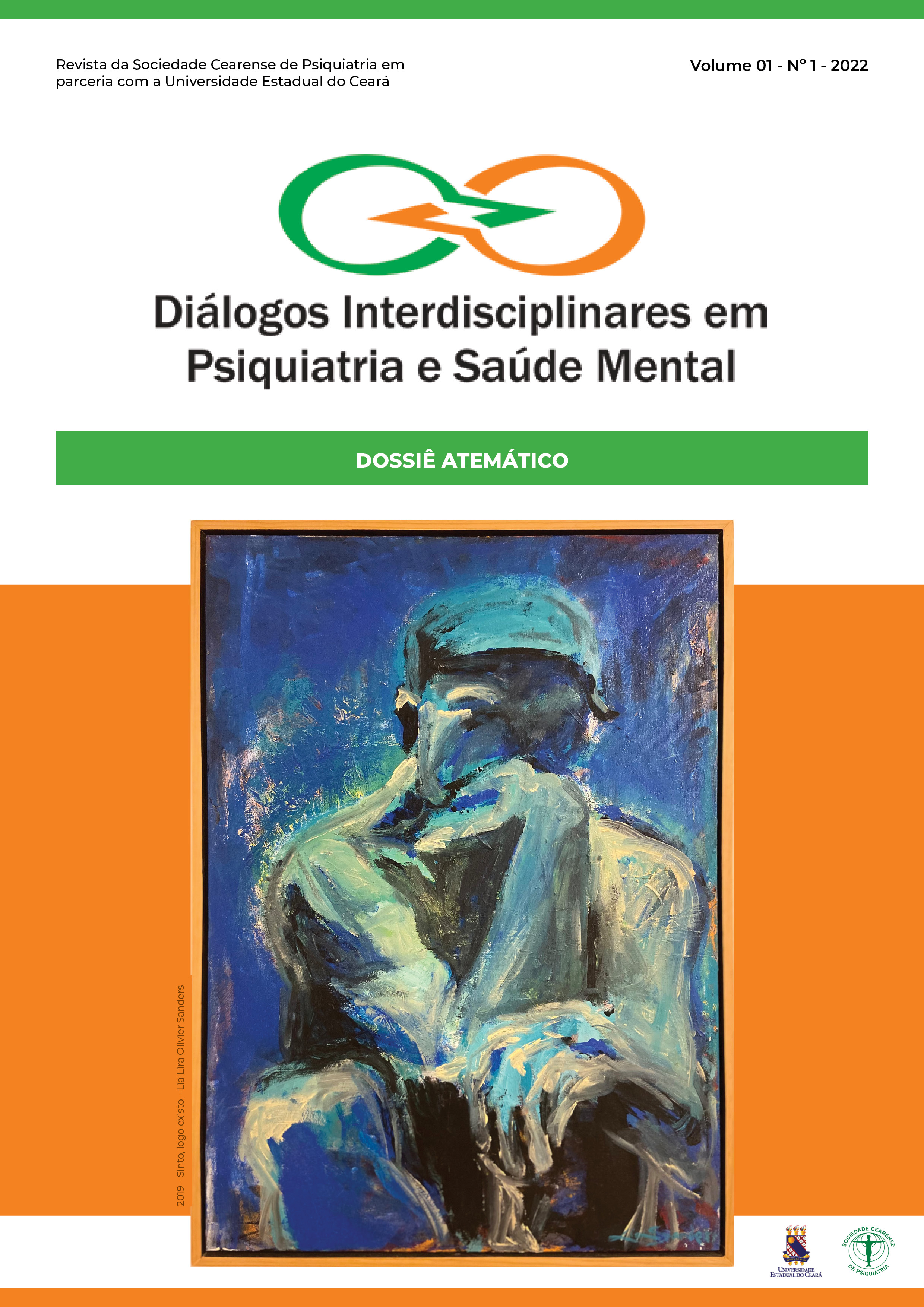The personality construct in a cognitive behavioral therapy perspective
Considerations of psychological assessment models
DOI:
https://doi.org/10.59487/2965-1956-1-7329Keywords:
Personality Assessment, Psychopathologies, Intervention techniquesAbstract
The personality construct has been studied by areas that seek to understand human behavior. The notion of personality has undergone significant changes through construction process, reflecting complexity. Human behavior is influenced by a set of factorsthat shape it, whether anthropological or cultural, socio-economic, biological or physiological and psychological. In this direction, the personality develops throughout life, being influenced by biopsychosocial factors, having points of stability and changes throughout the life cycle. When thinking about personality in two idiographic and nomothetic approaches, we recognize the dimensions that start from the particular, but that consider the collective dimension. The main objective of this study was to present the personality construct from a cognitive behavioral therapy (CBT) perspective and the considerations of psychological assessment models, in addition to presenting the definitions of the construct and its dimensions. Knowledge of the personality construct influences the assessment of human behavior and CBT interventions can help professionals to develop increasingly efficient intervention strategies. Based on the studies presented, it is concluded that the understanding of personality hassignificant impacts on the development of effective instruments and interventions.
Downloads
References
Carvalho, LDF, Pianowski, G, Reis, AM, Silva, RGC. Personalidade: o panorama nacional sob o foco das definições internacionais. Psicologia em Revista. 2015; 23(1), 123-146, 2017. doi: 10.5752/P.1678-9563.2017v23n1p123-146.
Pasquali L. (2000). Os Tipos Humanos: A Teoria da Personalidade. Brasília. LabPAM, 2000.
Allport GW. Personality: A psychological interpretation. Holt. APA, 1937.
Baptista NJM. Teorias da personalidade. ISMAI. Portugal, 2008.
Tavares M. Validade clínica. Psico-USF. 2003; 8(2), 125-136, doi: 10.1590/S1413-82712003000200004.
Roberts BW, Nickel, LB. A critical evaluation of the Neo-Socioanalytic Personality Development Across the Lifespan. 2017; 157–177. doi:10.1016/b978-0-12-804674-6.00011-9.
Beck, AT, Freeman, A, Davis DD. Terapia Cognitiva dos Transtornos de Personalidade. Porto Alegre: Artmed; 2005
Cloninger SC. Teorias da personalidade. São Paulo: Martins Fontes; 2003.
Diener E, Lucas RE. Personality Traits. In: Diener-Biswas, R, Diener E. Noba textbook series: Psychology.Champaign, IL: DEF publishers; 2018.
Millon T, Davis RD. Disorders of Personality. New York: Wiley; 1996.
Wiggins JS.Paradigms of Personality Assessment. New York: Guilford, 2003.
Lee K, Ashton, MC.Psychometric properties of the hexaco personality inventory. Multivar. Behav. Res. 2004; 39(2),329–358. doi:10.1207/s15327906mbr3902_8.
Holland JL. Making Vocational Choices: A Theory of Careers. Prentice-Hall, Prentice-Hall series in counseling and human development, 1973.
McCrae RR, Allik, J. The Five-Factor model of personality across cultures.New York: Kluwer Academic/Plenum Publishers; 2002.
McCrae RR. Cross-Cultural Research on the Five-Factor Model of Personality. Online Readings in Psychology and Culture. 2002;4(4). doi:10.9707/2307-0919.1038.
Trull TJ, Durrett, CA. Categorical and Dimensional Models of Personality Disorder. Annual Review of Clinical Psychology. 2005; 1(1), 355–380. doi:10.1146/annurev.clinpsy.1.102, 20.
Nunes CHSSN, Zanon C, Hutz, CL. Avaliação da Personalidade a Partir de Teorias Fatoriais de Personalidade. In: Trentini CM, Bandeira DR, Hutz, CL. Avaliação Psicológica da Inteligência e da Personalidade. Porto Alegre:Artmed; 2018.
Costa PT, McCrae RR. NEO-PI-R:Professional Manual, Florida: Psychological Assessment Resources Inc;1992.
Shi B, Dai, DY, Lu Y. Openness to Experience as a Moderator of the Relationship between Intelligence and Creative Thinking: A Study of Chinese Children in Urban and Rural Areas. Front. Psychol. 7:641. doi: 10.3389/fpsyg.2016.00641, 2016.
Ackerman PL, Heggestad ED. Intelligence, personality, and interests: evidence for overlapping traits. Psychol. 1997; Bull. 121(2), 219.
Kaufman SB, Quilty LC, Grazioplene RG, Hirsh JB, GrayJR, Peterson, JB, DeYoung, CG. Openness to experience and intellect differentially predict creative achievement in the arts and sciences. J. Pers. 2015; 84, 248–258. doi: 10.1111/jopy.12156.
Kerr B, McKay R. Searching for tomorrow’s innovators: profiling creative adolescents. Creat. Res. 2013. J. 25, 21–32. doi: 10.1080/10400419.2013.752180
Ziegler M, Cengia A, Mussel P, Gerstorf D. Openness as a buffer against cognitive decline: the openness-fluid-crystallized-intelligence (OFCI) model applied to late adulthood. Psychol. 2015; Aging 30, 573–588. doi: 10.1037/a0039493.
McCrae RR, Costa PT. The five-factor theory of personality. In: John OP, Robins RW, Pervin, LA. Handbook of personality: Theory and research. The Guilford Press; 2008.
Hayes N, Joseph S. Big 5 correlates of three measures of subjective well-being. Personality Individ. Differ. 2003; 34(4), 723–727. doi:10.1016/S0191-8869(02)00057-0.
Thoresen CJ, Kaplan SA, Barsky AP, Warren CR, de Chermont K. The affective underpinnings of job perceptions and attitudes: a meta-analytic review and integration. In: 17th Annual Conference of the Society for Industrial and Organizational Psychology, Toronto: An Earlier Version of This Study Was Presented at the Aforementioned Conference. American Psychological Association, 2003.
Hogan R, Curphy GJ, Hogan J. What we know about leadership: effectiveness and personality. Am. Psychol. 1994; 49(6), 493-504. doi: 10.1037/0003-066X.49.6.493.
Soto CJ, Kronauer A, Liang JK. Five-Factor Model of Personality. The Encyclopedia of Adulthood and Aging, 1–5, 2015. doi:10.1002/9781118521373.wbeaa0.
Carlo G, Okun MA, Knight, GP, de Guzman MRT. The interplay of traits and motives on volunteering: agreeableness, extraversion and prosocial value motivation. Pers. Individ. Differ. 2005; 38(6), 1293–1305.
LePine JA, Van Dyne L. Voice and cooperative behavior as contrasting forms of contextual performance: evidence of differential relationships with big five personality characteristics and cognitive ability. J. Appl. Psychol. 2001; 86(2), 326. doi: 10.1037/0021-9010.86.2.326.
Sackett PR, Walmsley, PT. Which personality attributes are most important in the workplace? Perspect. Psychol. 2014; Sci. 9(5), 538–551. doi: 10.1177/1745691614543972.
Soto CJ, John OP. Short and extra-short forms of the Big Five Inventory–2: The BFI-2-S and BFI-2-XS. Journal of Research in Personality. 2017; 68, 69–81.doi:10.1016/j.jrp.2017.02.004
Noftle EE, Robins RW. Personality predictors of academic outcomes: big five correlates of GPA and SAT scores. J. Pers. Soc. Psychol. 2007; 93(1), 116. doi: 10.1037/0022-3514.93.1.116.
Bogg T, Roberts BW. Conscientiousness and health-related behaviors: a meta-analysis of the leading behavioral contributors to mortality. Psychol. 2004; Bull. 130 (6), 887. doi:10.1037 / 0033-2909.130.6.887.
Ormel J, Bastiaansen A, Riese H, Bos EH, Servaas M, Ellenbogen M, Rosmalen JG, Aleman A. The biological and psychological basis of neuroticism: current status and future directions. Neurosci. Biobehav. Rev. 2013; 37(1), 59–72. doi:10.1016 / j.neubiorev.2012.09.004.
Resolução N° 009, de 25 de abril de 2018. Estabelece diretrizes para a realização de Avaliação Psicológica no exercício profissional da psicóloga e do psicólogo, regulamenta o Sistema de Avaliação de Testes Psicológicos -SATEPSI e revoga as Resoluções n° 002/2003, n° 006/2004 e n° 005/2012 e Notas Técnicas n° 01/2017 e 02/2017. Brasília, DF: Conselho Federal de Psicologia.
Hutz CS, Bandeira DR, Trentini C.M, Krug J.S. Psicodiagnóstico. Porto Alegre: Artmed; 2016.
Urbina S. Essentials of psychological testing (2nd ed.). Hoboken: Wiley; 2014.
Noronha APP, Barros MVC, Nunes MFO, Santos AAA. Avaliação psicológica: Importância e domínio de atividades segundo docentes. Estudos e Pesquisas em Psicologia, 2014; 14(2), 524-538.
CUNHA JA. Psicodiagnóstico. -V. Porto Alegre: Artes Médicas Sul; 2000.
Mazer AK, Macedo BBD, Jurena MF. Transtornos de Personalidade. Medicina. 2017. 50: 85-97(1).
John OP, Srivastava S. The Big Five trait taxonomy: History, measurement, and theoretical perspectives. Handbook of personality: theory and research. NewYork: Guilford (in press); 1999.
Costa PT, Mccrae RR. Revised NEO-PI-R and NEO five-factor inventory (NEO-FFI) professional manual. Odessa: Psychological Assessment Resources, 1992.
Clark LA, Cuthbert B, Lewis-Fernández R, Narrow WE, Reed GM. Three Approaches to Understanding and Classifying Mental Disorder: ICD-11, DSM-5, and the National Institute of Mental Health’s Research Domain Criteria (RDoC). Psychological Science in the Public Interest. 2017.18(2), 72–145. doi:10.1177/1529100617727266.
Bertsch K, Herpertz SC. Personality Disorders, Functioning and Health. Psychopathology 2018; 51(2), 69–70. doi:10.1159/000487971.
American Psychiatric Association (APA) Diagnostic and Statistical Manual of Mental Disorders 5th Edition.Washington (DC): APA; 2013.
Sevecke K, Schmeck K, Krischer M. The dimensional-categorical hybrid model of personality disorders in DSM-5 from an adolescent psychiatric perspective -criticism and critical outlook. Zeitschriftfür Kinder-und Jugendpsychiatrie und Psychotherapie. 2014; 42(4) 279–283. doi: 10.1024 / 1422-4917 / a000300.
Krueger RF, Hobbs AA. An Overview of the DSM-5 Alternative Model of Personality Disorders. Psychopathology. 2020; 53, 126-132. doi:10.1159/000508538.
Huprich S. Moving beyond categories and dimensions in personality pathology assessment and diagnosis. The British Journal of Psychiatry. 2018; 213(6), 685-689. doi:10.1192/bjp.2018.149.
Knapp P, Beck AT. Fundamentos, modelos conceituais, aplicações epesquisa da terapia cognitiva. Revista Brasileira de Psiquiatria. 2008; 30(2):54-64. doi: 10.1590/S1516-44462008000600002.
Greenberger D, Padesky, CA. A mente vencendo o humor: Mude como você se sente, mudando o modo como você pensa. Porto Alegre: Artmed, 2017.
zimmerman M, Black DH. Redefining Personality disorders:proposedrevisionforDSM-5.CurrentPsychiatry. 2011; 10:,26-38.
Araújo CF, Shinohara H. Avaliação e diagnóstico em terapia cognitivo-comportamental. Interação em Psicologia, 2002; 6(1), 37-43. doi:10.5380/psi.v6i1.3191.
Hunsley J, Allan T. Clinical assessment in cognitive-behavioral therapies. In: Dobson, KS, Dozois, DJA. Handbook of cognitive-behavioral therapies. The GuilfordPress; 2019.
Ridolfi ME, Gunderson, JG. Psychoeducation for patients with borderline personality disorder. In: Livesley, WJ, Larstone, R. Handbook of personality disorders: Theory, research, and treatment. The Guilford Press; 2018.
Leahy RL. Vença a depressão antes que ela vença você.Porto Alegre: Artmed; 2015.
Agostinho TF, Donadon MF, Bullamah, SK. Terapia cognitivo-comportamental e depressão: intervenções no ciclo de manutenção. Revista Brasileira de Terapias Cognitivas. 2019; 15(1), 59-65. doi: 10.5935/1808-5687.20190009.
Cordioli AV, Knapp P. A terapia cognitivo-comportamental no tratamento dos transtornos mentais: editorial. Revista Brasileira de Psiquiatria. 2008; 30 (2) 51-53. doi: 10.1590/S1516-44462008000600001.
Oliveira NH, Benetti, SPC. Aliança terapêutica: estabelecimento, manutenção e rupturas da relação. Arquivos Brasileiros de Psicologia. 2015; 67(3):125-138.
Downloads
Published
How to Cite
Issue
Section
License
Copyright (c) 2021 Maria Suely Alves Costa, André Sousa Rocha

This work is licensed under a Creative Commons Attribution 4.0 International License.










